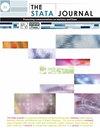解释logit模型
IF 3.2
2区 数学
Q1 SOCIAL SCIENCES, MATHEMATICAL METHODS
引用次数: 5
摘要
logit模型的参数通常难以解释,应用文献中充满了解释和计算错误。在本文中,我回顾了使用Stata正确有效地解释逻辑回归结果的选项菜单。我考虑了边际效应、部分效应、预测边际(对比)、弹性、几率和风险比。我还表明,交互术语在实践中通常比最近关于该主题的文献所暗示的更容易解释。本文章由计算机程序翻译,如有差异,请以英文原文为准。
Interpreting logit models
The parameters of logit models are typically difficult to interpret, and the applied literature is replete with interpretive and computational mistakes. In this article, I review a menu of options to interpret the results of logistic regressions correctly and effectively using Stata. I consider marginal effects, partial effects, (contrasts of) predictive margins, elasticities, and odds and risk ratios. I also show that interaction terms are typically easier to interpret in practice than implied by the recent literature on this topic.
求助全文
通过发布文献求助,成功后即可免费获取论文全文。
去求助
来源期刊

Stata Journal
数学-统计学与概率论
CiteScore
7.80
自引率
4.20%
发文量
44
审稿时长
>12 weeks
期刊介绍:
The Stata Journal is a quarterly publication containing articles about statistics, data analysis, teaching methods, and effective use of Stata''s language. The Stata Journal publishes reviewed papers together with shorter notes and comments, regular columns, book reviews, and other material of interest to researchers applying statistics in a variety of disciplines.
 求助内容:
求助内容: 应助结果提醒方式:
应助结果提醒方式:


